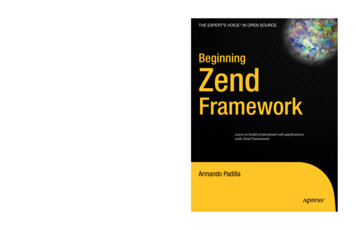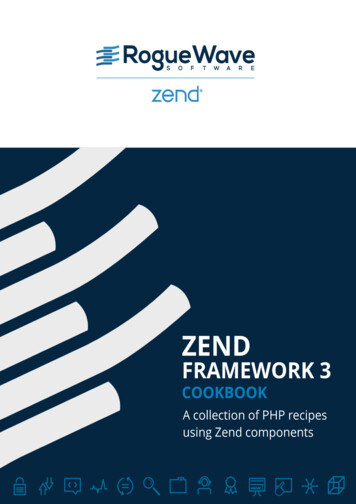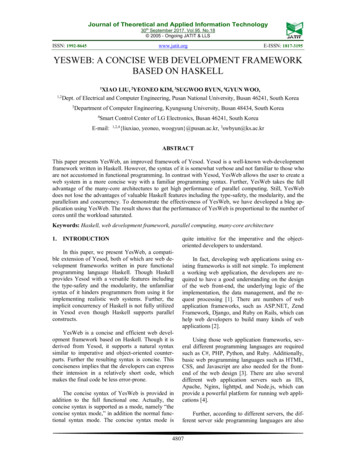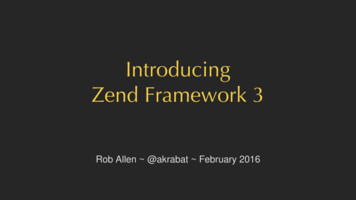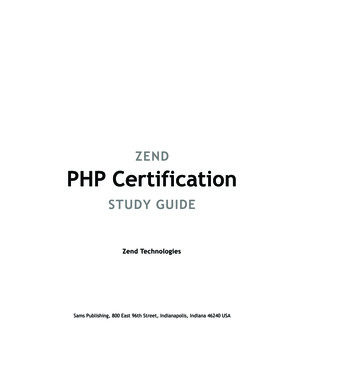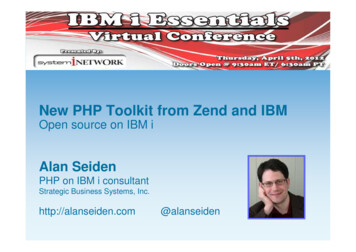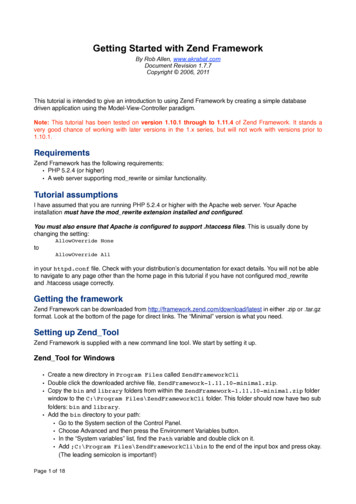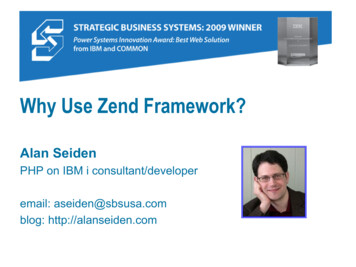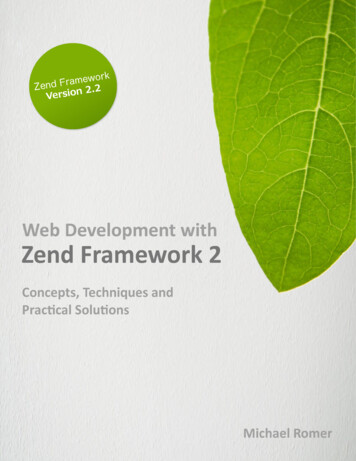
Transcription
Web Development with Zend Framework 2Concepts, Techniques and Practical SolutionsMichael RomerThis book is for sale at http://leanpub.com/zendframework2-enThis version was published on 2013-08-15This is a Leanpub book. Leanpub empowers authors and publishers with the Lean Publishingprocess. Lean Publishing is the act of publishing an in-progress ebook using lightweight tools andmany iterations to get reader feedback, pivot until you have the right book and build traction onceyou do. 2012 - 2013 by Michael Romer, Grevingstrasse 35, 48151 Münster, Germany,mail@michael-romer.de - All rights reserved.
Also By Michael RomerWebentwicklung mit Zend Framework 2Persistenz in PHP mit Doctrine 2 ORMPHP Data Persistence with Doctrine 2 ORMDeveloping Apps for Firefox OS
Contents1 Hello, Zend Framework 2! . . . . . . . . . . . . . . . . . .1.1 Installation . . . . . . . . . . . . . . . . . . . . . . . . .1.2 ZendSkeletonApplication . . . . . . . . . . . . . . . . .1.3 Composer . . . . . . . . . . . . . . . . . . . . . . . . .1.4 A first sign of life . . . . . . . . . . . . . . . . . . . . .1.5 Directory structure of a Zend Framework 2 application1.6 The index.php file . . . . . . . . . . . . . . . . . . . . .1122458
1 Hello, Zend Framework 2!Put away all the grey theory—let’s take a look at Framework in actionAs discussed in the last chapter, Zend\Mvc is an independent, optional, but essential componentof Framework. The following context always includes Zend\Mvc. Zend\Mvc also dictates its ownapplication and in a certain manner also the directory and code structure . But that is actually quitepractical. If one is already familiar with a Zend Framework 2 application, one can also orient oneselfvery quickly in other applications that are also based on Framework. Although one does indeed havethe freedom to establish a completely different directory and code structure, this would make lifeunnecessarily difficult, as we will see later. If an application to be created, it is wise to use Zend\Mvcfrom the very beginning. However, if one wants to extend an existing application with functionsfrom Zend Framework 2, it is perhaps appropriate to initially dispense with Zend\Mvc completely orto first use it at a later time.Zend Framework 1 and 2 in parallelOne can also operate Zend Framework 2 in parallel to Version 1 and initially only useZend Framework 2 intermittently.1.1 InstallationIn principle, Zend Framework 2 does not have to be tediously installed. One simply downloadsthe Code¹, makes it available over a web server with PHP installation and can begin immediately.However, the fact that the Zend Framework 2 Code alone is not enough to be able to actuallysee a Zend\Mvc-based application in action is a challenge because, as we have already mentioned,Zend\Mvc, i.e. the components which take over the processing of HTTP requests, isoptional and accordingly is also not inherently “wired” for use. One must thus initiallypersonally ensure that Zend\Mvc‘ is so equipped with configuration and initialisation logic—theso-called “boilerplate code”—that it can also actually be used. Otherwise, one initially sees nothing.To avoid this effort and to make getting started with Version 2 as simple as possible, the so-called“ZendSkeletonApplication” was developed in the course of Framework’s development; this servesas a template for one’s own project and includes the necessary “boilerplate code”, which one wouldotherwise have to prepare oneself with great effort.¹http://packages.zendframework.com/
Hello, Zend Framework 2!21.2 ZendSkeletonApplicationThe installation of the “ZendSkeletonApplication” is the simplest with help from Git. To takeadvantage of this, it is first necessary to install Git on one’s own computer. On Mac systems and inmany Linux distributions, Git is even already preinstalled. For installation on a Windows’ system,Git for Windows² is available for downloading. The installation under Linux nearly always runsunder the respective package manager. After installation and after invocation of1 git --versionon the command line, one should see this or a similar “sign of life”:1 git version 1.7.0.4From here onwards, everything is very easy—change to the directory in which the subdirectory forthe application is to be set up and which can later be made available to the web server as “documentroot”, and download the ZendSkeletonApplication .1 git clone tion.gitAdmittedly, in Git jargon it has to be termed “cloning” and not “downloading”. But for the timebeing, we will ignore that. And by the way, do not be afraid of Git! One does not need any advancedGit knowledge in order to successfully work with this book and Framework. Of course, the readercan also administer his or her own application code in the future even permanently— with Git, butit is not necessary. Therefore, a subversion, CVS or even no system at all can also be subsequentlyused for code administration without problems.Downloading the “ZendSkeletonApplication”” is very fast, even for less rapid Internet connections,but one must always have such a connection in any case. The reason for the fast download is the factthat Framework code itself is not downloaded at all; instead only the corresponding boilerplate codefor the development of one’s own application, which is based on Zend Framework 2, is provided.1.3 ComposerThe “ZendSkeletonApplication” uses with Composer³ another PHT tool, which established itselffor the management of dependencies for other code libraries some time ago. The idea behind thecomposer is as simple as it is ingenious. A configuration file contains a definition of the other codelibraries that an application is dependent on and from where the respective library can be obtained.In this case, the application is dependent on Zend Framework 2, as can be seen by looking in the filecomposer.json in the application ser.org/
Hello, Zend Framework 2!1{"name": : "Skeleton Application for ZF2","license": "BSD-3-Clause","keywords": ["framework","zf2"],"homepage": "http://framework.zend.com/","require": {"php": " 5.3.3","zendframework/zendframework": "2.*"}2345678910111213143}Listing 4.1⁴In lines 11 and 12, the application’s two dependencies are declared. Both PHP 5.3.3 or higher andthe current version of Zend Framework 2 are required. The following two invocations ensure thatZend Framework 2 is downloaded and additionally also integrated in the application such that it isimmediately utilisable and the corresponding Framework Classes are made available by autoloading.123 cd ZendSkeletonApplication php composer.phar install Installing zendframework/zendframework (dev-master)Composer has now downloaded Zend Framework 2 and made it available for the application in thevendor directory.Phar-ArchiveA Phar Archive provides the option of making a PHP application available in the formof a single file. If one looks at the Composer-Repository at GitHub⁵, it becomes clear thatcomposer does not consist of a single file, as one might think, but that its componentsare merely bundled in a Phar Archive for distribution of the ttps://github.com/composer/composer
Hello, Zend Framework 2!4Phar Archive and SuhosinIf “Suhosin””⁶ is used on a system, the use of Phar must initially beexplicitly permitted such that the suhosin.ini is extended by the entrysuhosin.executor.include.whitelist phar. Otherwise, problems can occur inthe execution of the Composer command.Installation without Git or ComposerIf necessary, it is also possible to obtain Framework and the “ZendSkeletonApplication”via a “normal download” or Pyrus (the successor to PEAR). Additional installationinformation is to be found on the official download site⁷.1.4 A first sign of lifeWe have now completed nearly all of the required preparations. Finally, we only have to ensure thatthe application’s public directory is configured as Document Root of the web server and can becalled up/invoked via the URL ‘http://localhost by the browser.For example, to achieve this, a directive in following exemplary form must be specified in thehttpd.conf of Apache:123[.]DocumentRoot /var/www/ZendSkeletonApplication/public[.]where it is required that the “ZendSkeletonApplication” was downloaded with the followingcommand beforehand:12 cd /var/www git clone http://framework.zend.com/downloads
5Hello, Zend Framework 2!Setting up a PHP runtime environment.Since the scope of my readers’ previous knowledge is probably extremely different, Iwill not explain exactly how a web server is installed on a system together with PHPat this time, but instead presume that my readers already know this. For anyone whoneeds assistance, additional information and support are to be found in the Appendix ofthis bookIf these configurations have been made, Zend Framework 2 should show itself for the first timewhen http://localhost is called up in the browser:Start page ZendSkeletonApplication of Zend Framework 21.5 Directory structure of a Zend Framework 2applicationNow, we can finally look at it, a Zend\Mvc-based Zend Framework 2 application with its characteristic directory layout and the typical configuration and initialisation le/vendor/
Hello, Zend Framework 2!101112136public/.htaccessindex.phpdata/In our case the “Application Root” is the ZendSkeletonApplication directory, which is automatically generated by cloning the appropriate GitHub repository. In the config directory, there is,on the one hand, application.config.php, which contains the basic configuration for Zend\Mvcand its collaborators as a PHP array. In particular, the ModuleManager is configured there; wewill frequently talk about its details in the course of the book. If required, the autoload directorycontains additional configuration data in the form of additional PHP files; initially, this seemsa bit strange, but one becomes accustomed to it. To begin with, the directory’s designation as“autoload” is a bit irritating. In this location, “Autoload” has nothing to do with the “Autoloading”of PHP Classes, but instead indicates that the configurations that are filed in this directory will beautomatically taken into consideration. And that occurs chronologically after the configuration ofthe application.config.php and also after the configurations performed by the individual modules,which we will talk about later. This sequence of configuration evaluation is extremely importantbecause it allows the situation-dependent overwriting of configuration values. The same principleapplies to global.php und local.php: configurations in the global.php are always valid, but theycan be overwritten by configurations in the local.php. Technically speaking, Framework initiallyreads in the global.php and subsequently the local.php, whereby previously defined values canbe replaced, if necessary. What is that good for? In this manner, configurations can be definedindependently of the runtime environment. Let us assume that the programmers of an applicationhave set up a runtime environment locally on their computers. Since a MySQL database is requiredfor the application, all of the developers have installed this on their computers and in the process haveconfigured the access rights such that passwords, which the respective developers also otherwisefrequently use, are utilised. It is indeed more convenient. However, since each developer potentiallyhas an individual password for the database, this configuration cannot be hard-wired, but mustbe individually specified. To achieve this, the developer enters his or her connection data in thelocal.php file, which he or she maintains locally in the computer and does not check into thecode administration system either. Whereas the connection data for the “live system” are depositedin global.php file, every developer can work with his or her own connection data, which aredefined with the aid of the local.php. In this manner even special configurations for test or stagingsystems can be deposited. Incidentally, configuration files of the form “xyz.local.php” (also appliesto “global”), for example db.local.php, are also processed by Framework as described above.The individual modules of the application are located in the Module directory. Each module comeswith its own typical directory tree, which we will take a closer look at later. However, at this time theimportant thing is that every module can also have its own configuration. We now have three placesin which something can be configured: application.config.php, module-specific configurationand the global.php and local.php files (or their “specialisations” as described above), which thesystem reads in exactly this order and ultimately provide a large, common configuration object,because in the course of execution exactly these configurations are merged. If the configurations
Hello, Zend Framework 2!7of application.config.php are only of interest in the first few meters of bootstrapping, theconfigurations of the modules and those from global.php and local.php are also important inthe later course of the processing chain and are generously made available by the ServiceManager.We will also learn more about this later. The attentive reader realises at this time that as a result ofthis “configuration cascade”, for example module configurations that flow into the application fromthird party manufacturers’ modules can be extended or even replaced. This is very practical.The vendor directory contains conceptionally the code which one did not write oneself (ignoringthe “ZendSkeletonApplication” code at this time, but which one could have had to write oneselfin case of doubt) or which one did not write especially for this application. Zend Framework 2is thus located approximately there, but, if necessary, also in other libraries. When dealing withadditional libraries, one must always ensure that the corresponding classes can be addressed by theapplication. However, if one can install the respective library using composer, this work does nothave to be done by the developer either. The installation of additional libraries should therefore in theideal case always be performed using composer. The fact that also the ZF2 modules, which actuallyshould be located in the module directory, can also be made available via the vendor directoryis also interesting. (To be perfectly correct, one would have to say that is can be configured viaapplication.config.php and the modules can therefore basically be deposited anywhere.) Thismeans that third party manufacturers’ libraries that adhere to the Zend Framework 2 modulestandard can also be added in this manner. Thus, one can ensure that only those modules that oneactually developed in the scope of the respective application are located in the module directory. Allother modules can also be made available via vendorAll files that are to be made externally accessible via the web server (with the exception of specificrestrictions in web server configuration) are located in public. This is also the place for images CSSor JS files as well as for the “central entry point”, the index.php. The idea behind this is that everyHTTP request that reaches the web server and a specific application initially results in calling upthe index.php. Always. Regardless of how the URL call itself is formulated. The only exceptions areURLs that refer to an actually existing file within or below the public directory. Only in this case,does the index.php not perform the execution, instead the appropriate file is read and returned. Thismechanism is achieved by a typical Zend Framework .htaccess file in the public directory:123456RewriteEngine OnRewriteCond %{REQUEST FILENAME} -s [OR]RewriteCond %{REQUEST FILENAME} -l [OR]RewriteCond %{REQUEST FILENAME} -dRewriteRule .* - [NC,L]RewriteRule .* index.php [NC,L]In order for this to function, several conditions must be fulfilled. On the one hand, the web servermust be equipped with a so-called RewriteEngine⁸, which must also be activated. On the other hand,the web server has to allow an application to set directives via its own .htaccess. To achieve this,the [following directive] must be exemplarily in the Apache ent/mod/mod rewrite.html
Hello, Zend Framework 2!18AllowOverride AllThe data directory is relatively unspecific. Basically, data of all kinds, which have anything todo with the application (documentation, test data, etc.) or that are generated in the running time(caching data, generated files, etc.), can be deposited there.1.6 The index.php fileEvery request that does not map onto a file that actually exists in the public directory is thusredirected via the .htaccess file to the index.php. It therefore has a special importance for workwith Zend Framework 2. At this time, it is again important to realize that the index.php itself isnot part of Framework, but that it is indispensible for using the Framework’s MVC components.Please remember: Zend\Mvc is the component that represents the “processing framework” for anapplication. The index.php comes with the ZendSkeletonApplication; thus, we do not have todevelop it ourselves.Because of the importance of the index.php — both for Framework and for our understanding ofFramework’s mechanics—we will now risk a detailed look at this very easily understood file:1234 ?phpchdir(dirname( DIR ));require 'init autoloader.php';Zend\Mvc\Application::init(include 'config/application.config.php')- run();Listing 4.1To begin with, we will change to the application root directory of the application, in order to be ableto easily refer to other resources. Then init autoloader.php is called up; this initially triggersautoloading by composer. This nondescript call-up ensures that all the libraries that have beeninstalled by composer automatically make their classes available via autoloading mechanisms:123456 ?php// [.]if (file exists('vendor/autoload.php')) { loader include 'vendor/autoload.php';}// [.]Listing 4.2Consequently, we can dispense with all require() call-ups in the application. The few lines that Ihave written down here in such an emotionless manner actually represent an enormous attainment
Hello, Zend Framework 2!9for us as PHP developers: It simply could not be easier to integrate libraries into one’s ownapplication.In the init autoloader.php, the autoloading of the ZF2 classes via the environment variable ZF2 PATH or via Git submodule is then also alternatively ensured, just in case that one did not obtainZend Framework via composer because in that case the above-mentioned autoloading mechanismof composer is sufficient. With the aid of the environment variable ZF2 PATH, for example, a numberof applications in the system can use a central installation of the framework code. Whether or notthis is truly expedient, I cannot really say. Now, a brief check to see whether Zend Framework 2 cannow be loaded—otherwise nothing will happen—and then we can get started:12345 ?php// [.]Zend\Mvc\Application::init(include 'config/application.config.php')- run();Listing 4.3The call-up of the class method init() of the Application initially ensures that the ServiceManageris superimposed. The ServiceManager is the central object in Zend Framework 2. It allows otherobjects to be accessed in many ways, is normally the “principal point of contact” in the processingchain and is also the first entry point in general. We will consider the ServiceManager later ingreater detail. For simplicity’s sake, one can initially imagine the ServiceManager as a sort ofglobal directory, in which an object can be deposited under a defined key. For all those who havealready worked with Framework Version 1, the ServiceManager thus initially presents itself as asort of Zend Registry. At this point, we should perhaps make a small leap forward. Not onlypreviously generated object instances come into consideration as values that can be deposited inthe ServiceManager under a stipulated key, but also “Factories”, which generate the respectiveobjects—in the context of the ServiceManager analogously designated as “services”. The underlyingidea is that these services can only then be generated when they are really needed. This procedure istermed “lazy loading”, a design pattern intended to delay memory and time-consuming instancingof objects for as long as possible. Indeed, some a number of services for some types of requests arenever needed; why should the always be instanced beforehand?But back to the code: The init() method is transferred to the application configuration as parameter,and this has already been taken into consideration by the generation of the ServiceManager:
Hello, Zend Framework 2!1234567810 ?php// [.] serviceManager new ServiceManager(new ServiceManagerConfig( configuration['service manager']));// [.]Listing 4.4At this point, the ServiceManager is now initialised and equipped with those services which arerequired in the scope of processing of requests by Zend\Mvc. However, the ServiceManager can alsobe effectively used for completely different purposes, beyond Zend\Mvc.Subsequently, the application configuration itself is deposited in the ServiceManager for later use.1234 ?php// [.] serviceManager- setService('ApplicationConfig', configuration);// [.]Listing 4.5Then the ServiceManager is asked to perform its services for the first time.1234 ?php// [.] serviceManager- get('ModuleManager')- loadModules();// [.]Listing 4.6The get() method requests a service. Incidentally, in this situation we already have a case in whichthe ServiceManager does not return an instantiated object, but instead uses a “factory” to generatethe requested service, by acclamation as it were. In this case, the Zend\Mvc\Service\ModuleManagerFactoryis used, and generates the requested ModuleManager.But how does the ServiceManager actually know now that whenever the ModuleManager service isrequested that the above-mentioned factory is to be called upon for its generation? Let us again lookat the code ahead of it:
Hello, Zend Framework 2!12345611 ?php// [.] serviceManager new ServiceManager(new ServiceManagerConfig( configuration['service manager']));// [.]Listing 4.7As a result of the transfer of ServiceManagerConfig, the ServiceManager is prepared for the use ofZend\Mvc and has registered exactly that factory for the ModuleManager, among other things. In thefollowing chapters, we will take another look at all of this in greater detail and also look at the otherservices which are provided as standard.But let us now return to the code sequence: After the ModuleManager has now been made availablevia the ServiceManager, the loadModules() method initialises all the modules activated by theapplication.config.php, If the modules are ready, the ServiceManager is again contacted andthe “application”” service is requested from it.1234 ?php// [.]return serviceManager- get('Application')- bootstrap();// [.]Listing 4.8This fact may appear a bit strange, especially since the entire processing sequence indeed originallybegan via a Zend\Mvc\Application. But it now becomes clear that its init() method initially onlyinitialised the ServiceManager, whereas the Application itself is then itself generated as a service.Now a very complex procedure, which is responsible for the processing of the request itself, begins.The “application” is prepared (“bootstrapping” occurs). Back in the index.php, the application isthen executed and the result is returned to the calling program.12345 ?php// [.]Zend\Mvc\Application::init(include 'config/application.config.php')- run();// [.]Listing 4.9I have devoted a chapter in this book to the exact consideration of the request processing because ofits importance, but also of its complexity. Until we get to it, we will keep this in mind: The index.php
Hello, Zend Framework 2!12is the central entry point for all requests that are processed by the application. These very requestsare technically rerouted to the index.phpby .htaccess. The actual URL that was called up by theuser is naturally maintained and is subsequently read by Framework in order to locate an appropriatecontroller with its action. The ServiceManager is at the focus of the processing and gives access tothe services of the application. Therefore, we must initially generate the ServiceManager, before itcan, in turn, give us access to the ModuleManager, with whose help we can bring both the registeredmodules and the Application, which is responsible for processing the requests, to life. So far, sogood.Zend Framework 2 with alternative web serversNaturally, can alternative web server instead of Apache—such as nginx⁹—be used. Inthis case, only the Apache-specific configuration as well as that of .htaccess are to beanalogously transformed, for example with the help of the “nginx rules”.⁹http://nginx.org/
Hello,ZendFramework2! 4 PharArchiveandSuhosin If "Suhosin""⁶ is used on a system, the use of Phar must initially be explicitly permitted such that the suhosin.ini is extended by the entry suhosin.executor.include.whitelist phar.
